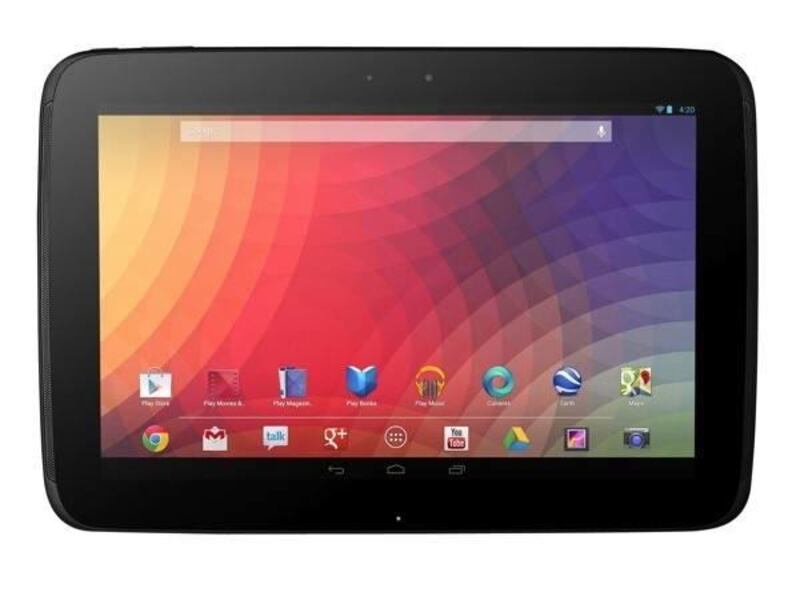Over the past few years, phones powered by Google’s Android operating system have overtaken Apple’s dominant iPhone as the market share leader. This has been welcome news for Google and its affiliates, but challenges remain, namely in the tablet space.
Apple’s iPad remains largely untouched as the king of tablets, and minor skirmishes with Android upstarts have resulted in sluggish sales for Android tablets while the iPad continues selling at an impressive pace. However, all is not well in Cupertino, as Apple’s recent Q3 earnings report showed a slide in iPad sales, and the recently-announced fourth generation iPad and iPad mini have been met with mixed reviews.
Enter Google, which, while having fought a proxy war with Apple for a number of years, is finally stepping forward with its own 10-inch tablet, dubbed the Nexus 10. “Nexus” in Google speak means a special line of devices unencumbered by manufacturer ad-ons, or “vanilla Android,” as enthusiasts call it — which, on paper, boasts hardware specifications better than the refreshed iPad, and at a cheaper price. Hardware, however, is not the only story, and only time will tell how the Nexus 10 rates in terms of real-world use.
The main feature of the Nexus 10 that has people taking notice is its screen. Screen resolution has long been a selling point for Apple, with its line of “Retina display” devices that offer clearer picture in a smaller space, with pixels barely visible to the naked eye. The current iPad has a resolution of 2048 x 1536 pixels on a 9.7-inch screen, which gives it a pixels-per-inch (or ppi) density rating of 264. It is a gorgeous screen; there are no two ways about it.
The Nexus 10 has a resolution of 2560 x 1600 on a 10.1-inch screen, giving it a ppi of 300, which seems to handily put the iPad in a corner.
There are two measurements to consider when making sense of all of this: resolution and ppi, which, while linked, are dependent on other factors, particularly screen size.
For example, your big, 55-inch LCD or plasma TV at home maxes out at resolution of 1920 x 1080. It looks great with that 1080p picture, but if ppi were a selling point for TVs, that TV would have a ppi of 40. Yep, 40. Yes, your tablet has a better screen than your TV. Life is hard.
So why do TV manufacturers get away with this? Because we sit far enough away from the screen that we don’t perceive the pixel density. Mobile device makers do not have that luxury, since the devices are usually no more than 12 to 18 inches from our face.
The Nexus 10, therefore, is not the first Android device to beat an Apple product in terms of screen resolution alone, but it is the first mobile hardware to offer a better ppi than an Apple product. Only through actual tests will we see how well the screen truly performs, as issues like viewing angles, black levels and other metrics will also factor in to the overall usefulness of it.
As for other specifications, the Nexus 10 comes shipped with Android 4.2 (Jelly Bean), a dual-core processor, a 1.9-megapixel front-facing camera (5 mp rear with LED flash) and stereo speakers, and weighs 603 grams on a device .02 inches thinner than the iPad. The 32GB Nexus 10 costs $499 (16GB for $399). By comparison, Apple’s 32GB Wi-Fi iPad is $599.
Battery life, however, is rated at nine hours compared to the iPad’s 10, and the Nexus 10 is also WiFi-only, which means no mobile data unless you tether it to your phone.
Also, the Nexus 10 is just not as svelte as the iPad. Apple knows how to make sexy devices. If Apple is the siren turning heads at prom, Android devices are the nerdy kids with a lot to offer, but have difficulty showing it on the outside.
Does Google finally have a tablet worth sending into battle against the iPad? After allowing its hardware manufacturers to spend a few years lobbing small rocks at the iPad, Google seems to have finally arrived with a trebuchet and a big, high-resolution boulder.
Plus, “Retina display” is trademarked. What concise brand name can Google use to give the Nexus 10 the panache of its Cupertino rival — “Mountain View Magic”?
Geoff Openshaw is a graduate of the University of Edinburgh and works as a social media consultant. He hosts the This Week in Mormons podcast, which is published weekly at http://thisweekinmormons.com Twitter: TheShippingLane email: me@geoffopenshaw

